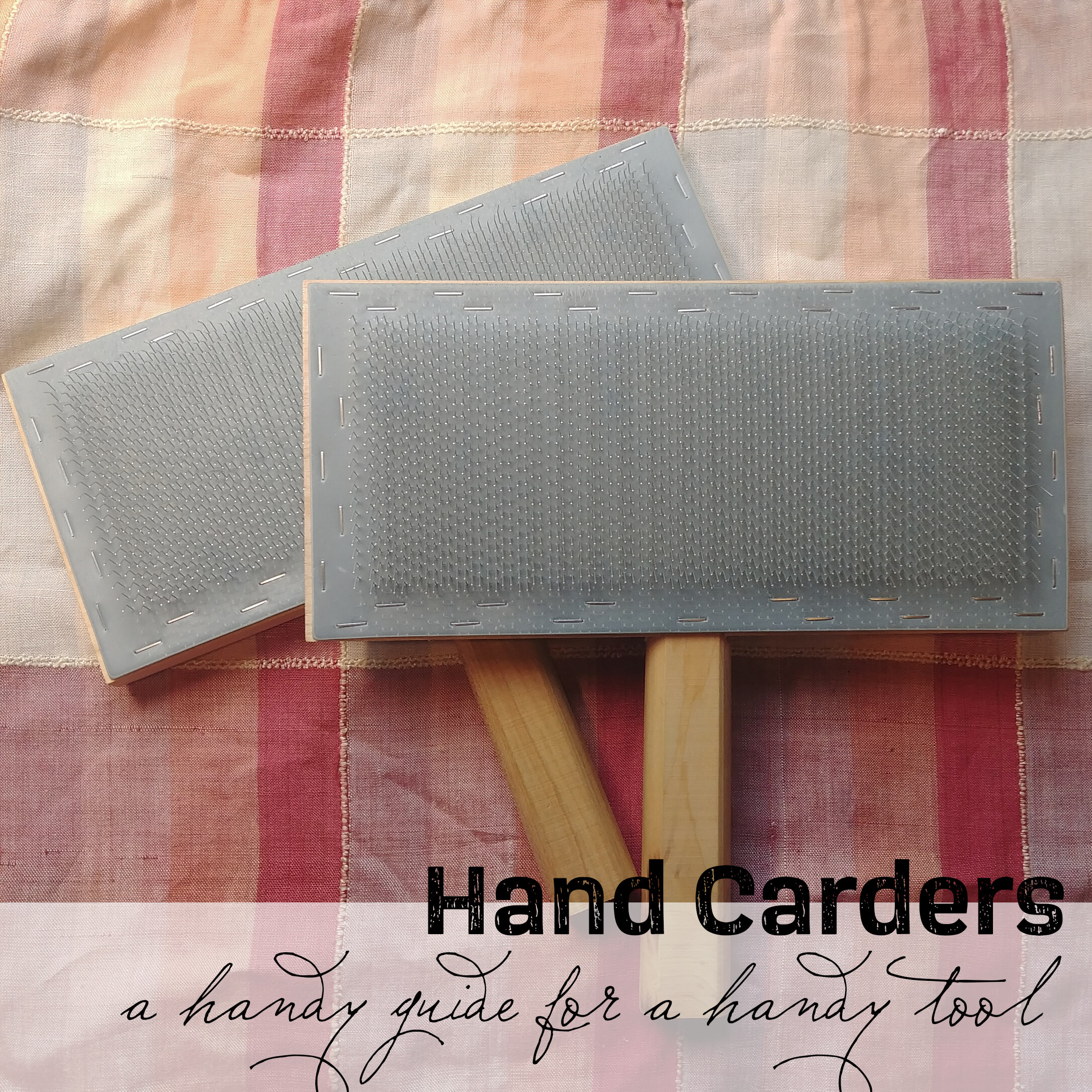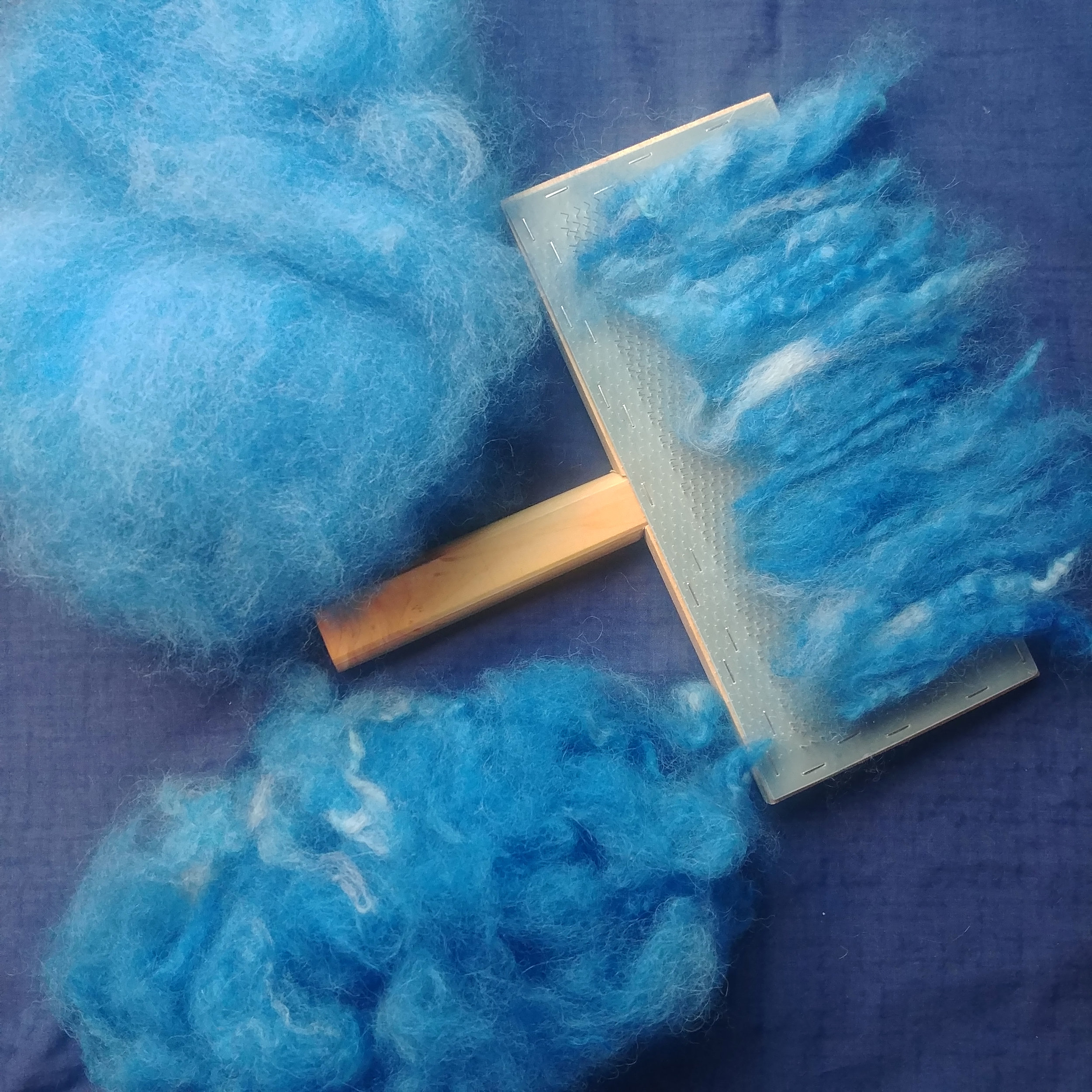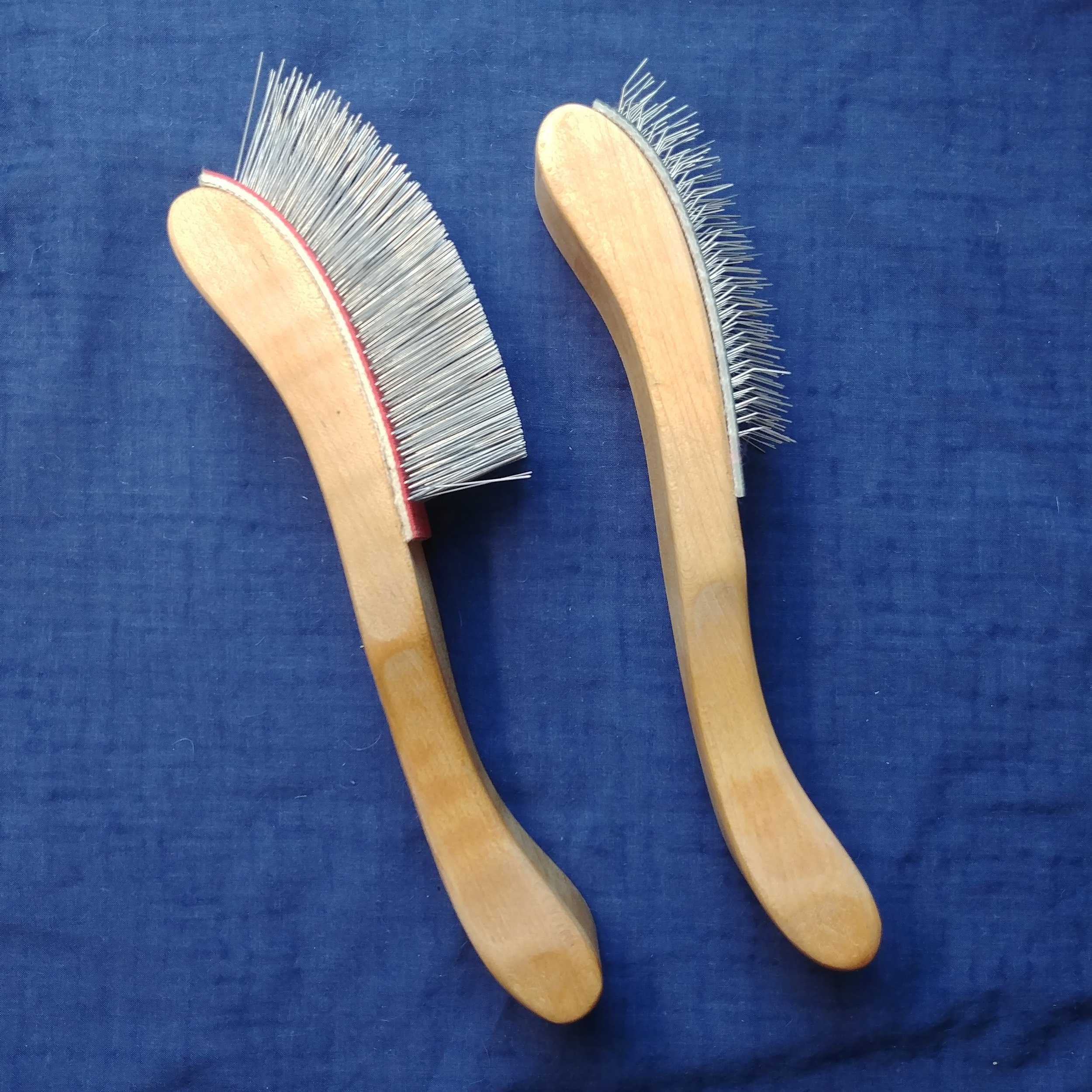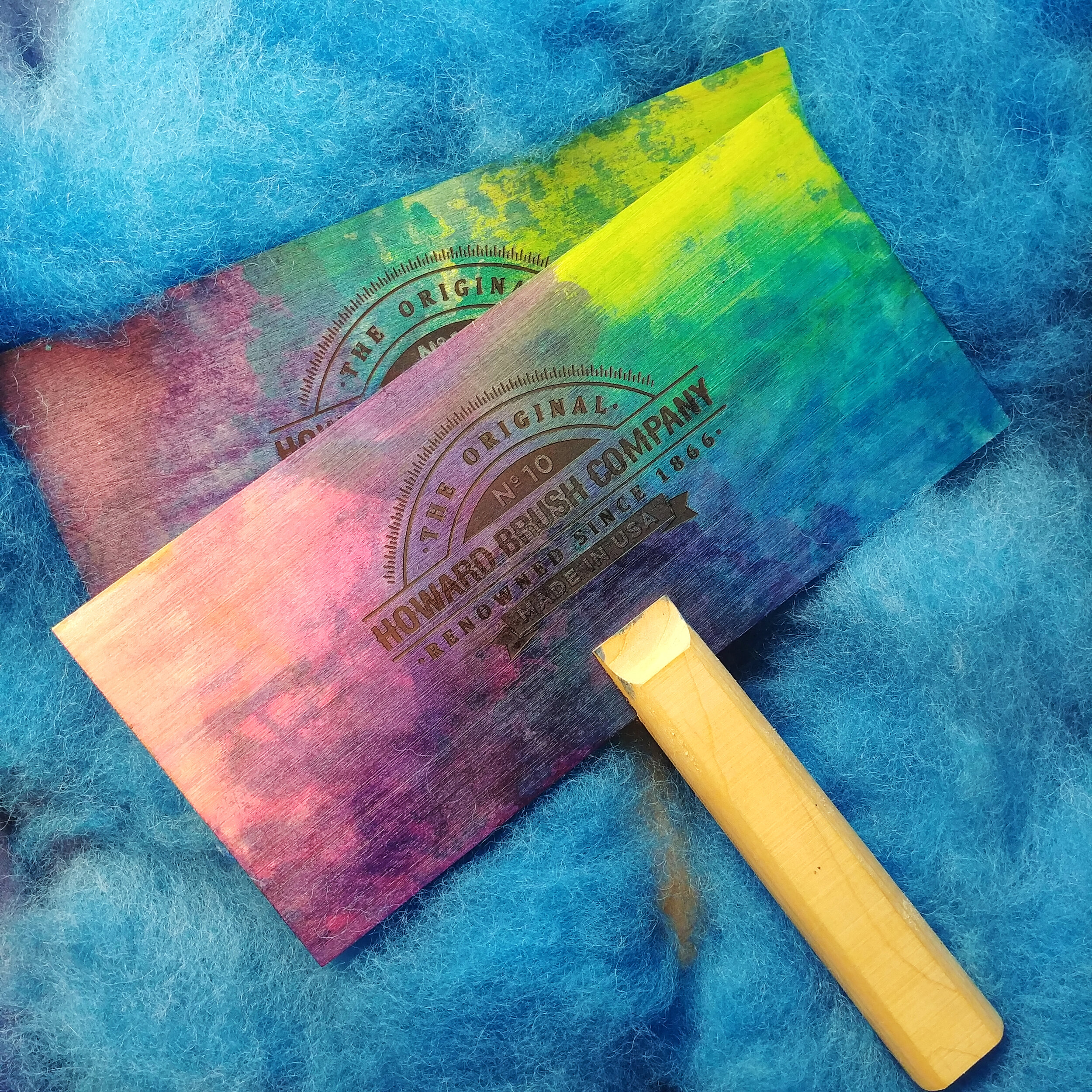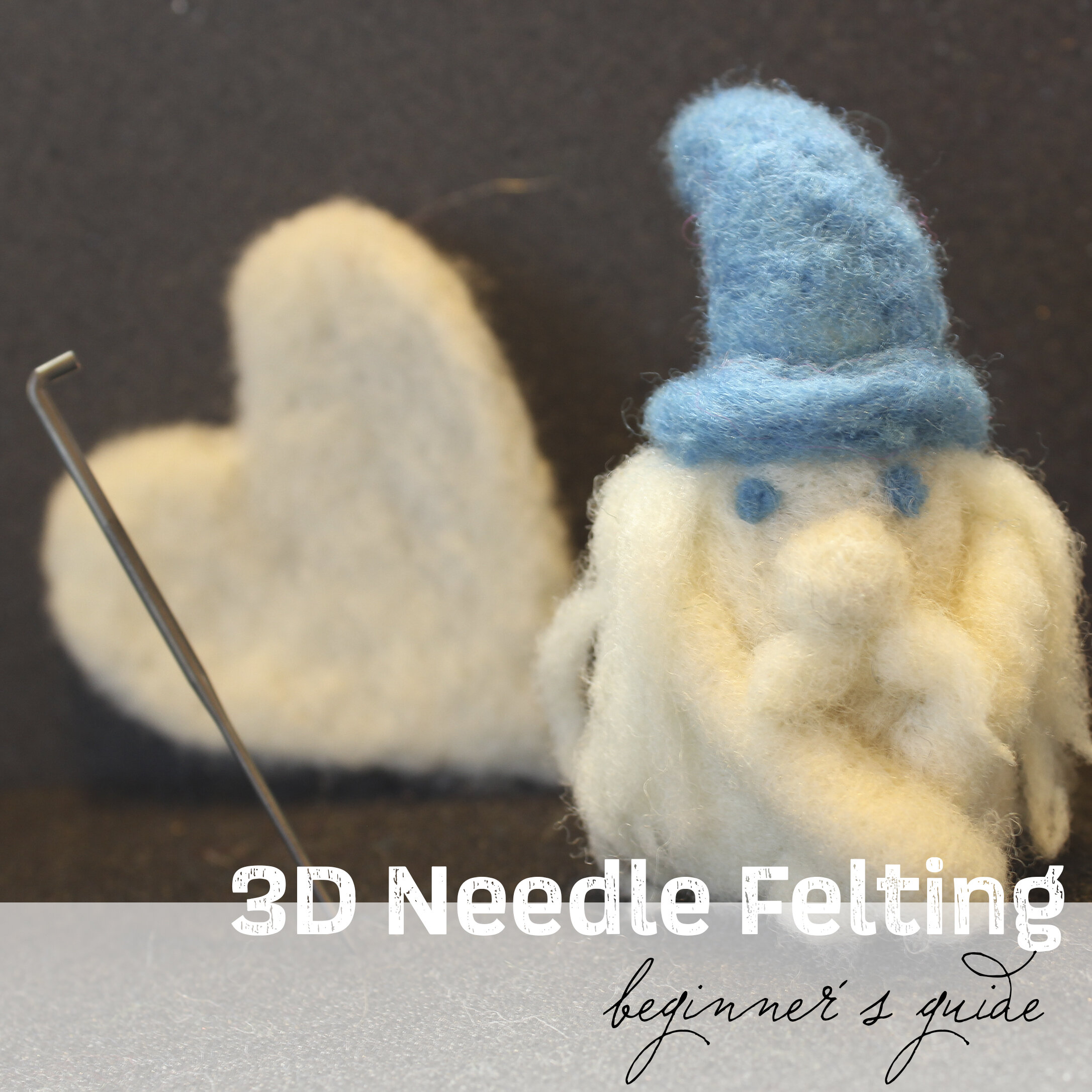Guide to Hand Carders
FTC Disclosure: Please note that some of the links in this post are affiliate or referral links (full disclosure here), and if you make a purchase or sign up for a service within a certain timeframe after clicking on one of those links, I may earn a small commission paid by the retailer at no extra cost to you. I wouldn't recommend anything that I don’t or wouldn't use myself. Thank you for your support!
This post was last edited/updated in March 2021.
Update 2021: Of all my fiber tools, I find myself reaching for my hand carders the most, because they’re handy (pun totally intended). Especially after 2020 since I work at my desk these days - my husband has been working from home out of my fiber studio space since March 2020, which is where all my other fiber stuff is located, and this way I can just grab these and go. They’re really a great tool to have on hand.
Considering I already own both a drum carder and a blending board, as well as a pair of dog brushes I purchased way back for blending small amounts of fiber together, I thought that maybe hand carders would be a bit… redundant? That being said, if you want to get into fiber prep and/or spinning, but don’t want to invest in a drum carder just yet, hand carders are definitely the way to go. Blending boards aren’t really good for carding raw fiber and a bit more in a league of their own - they’re best used for already carded wool (unless you want to preserve the lock structure of course) for the purpose of creating a base for felting projects or large rolags for spinning, or even for blending large amounts of wool.
I thought it would be nice to have a pair of carders, maybe so I can watch TV while carding. After all, dog brushes aren’t really good for carding a lot of wool, and I’ll get into the difference between pet brushes and carders in a bit. Or how maybe pre-carding by hand (since I don’t have a picker) would help me get smoother batts. Maybe I have a bunch of dyed wool but I don’t want to card the whole batch when I just want to include some of it on my blending board to make a few rolags for spinning. I stopped dyeing carded wool a while back and just started throwing in the cleaned locks in the dye pot, and rather than immediately carding everything I dyed, I toss them into zippered delicates bags in similar hues. The reason I do this is because I feel that it leaves me with more options. Maybe I want to maintain the texture and color variations of a lock in a felting project. Maybe I want to card some of them together. Sure, I can card already carded batts together, but every time you run it through the carder, it smooths it out more, and if I want to make a chunky textured batt, I don’t want anything pre-carded.
Carding alpaca fiber - I’m just leaving it in a fluffy cloud rather than doing rolags here.
Of course, I could have just been looking for ways to justify wanting to own all-the-fiber-art-things, and that was one thing I was missing. Then I read this on Howard Brush’s website under their drum carder instructions (all my tools are HB, I like their products and price point), “For speed and ease of spinning, I don’t think you can beat the little batt from hand cards. That’s why I like to hand card my drum-carded batts.” Well, okay then, I’m not going to argue. Yes, I did figure out that a blending board would have been good for this as well, that is, making rolags, not carding. I found a a shop which sells Howard Brush outlet, which had a pair of carders cheaper than new ones off the site (and much cheaper than other brands). I have no idea why they are outlet, considering they look to be in perfect, usable shape, brand new, with no visible damage. Many of the reviews said the same. That being said, if you want something more name-brand for your felting tools, Woolery has a decent selection of hand carders and you can find a number of them on Amazon as well, including Ashford, Schacht, Louet, and Clemes & Clemes, (all of which have curved backs). I believe the Ashford student carders are flat-backed. I wouldn’t recommend a high TPI for wool (anything more than 72 TPI), especially for needle felting where you will use coarser wools.
How in the world can there possibly be so many different options for what are essentially two rectangular ping pong paddles with a painfully spikey cloth stapled on them? TPI? Flat? Curved? Half-flat-half-curved? Mini? Student? Standard? What? And what are all the other carders mentioned on there? Fiber blenders? Flickers? Finishing brush? Blending brush?
72 TPI hand carder on the left, large dog brush that I use for blending fibers on the right
Before I explain all the hand carder options, I’ll first share the difference between a dog brush and a hand carder. First of all, while the points look similar from a side profile (they’re bent at an angle in order to brush out stray hairs), the points on a dog brush are spaced very differently (at least on my dog brushes). There are evenly spaced columns of points, but horizontally they seem to be a bit more haphazard with no definable rows or pattern to them really. Looking at the points on a hand carder, although there aren’t any rows to them either, there’s definitely a pattern, in which the points are all equally spaced.
The second difference is that the points on a hand carder are far more stiff and painfully pokey than the ones on a dog brush. Ergo, I have no issue giving my kids my dog brushes to blend some wool, but I remind them to be extra extra careful with any of my carding stuff. You can brush your arm with a dog brush and, while a bit unpleasant, nothing will happen - which is a good thing too, because if you tried putting a hand carder to your beloved furbaby, you’d end up with a bloody mess, and a poor suffering pup likely to be permanently traumatized from any future grooming efforts. So I think it goes without saying, keep your hand carders far away from your pet supplies to avoid making a terrible mistake.
Are pet slicker brushes still handy when it comes to fiber? Absolutely (just make sure you get two - the hand carders come in sets)! I still use them for blending small amounts of fiber, and because the points aren’t sharp, you can use them to clean your carding cloths (on your drum carder or blending board or even your hand carders) without damaging the cloth. Another option is to get a stiff boar bristle brush to do this. You can also purchase a doffer brush, which does the same thing.
First let’s get into the other brushes you might find, and then we can get into the hand carders themselves.
The Howard Brush flicker brush
flicker brush
Flicker brushes are used to open up the ends of locks before carding or spinning. The points, which are quite stiff and sharp, are significantly deeper than the tines you find on hand carders. To do so, you want to put a very thick cloth over your lap so you don’t damage your clothes or scratch up your legs, like a piece of canvas (maybe doubled up), one of those thick plastic reusable shopping bags, or even a piece of leather - rather than buying something new, maybe find a large leather bag at the thrift store you can cut up? You place the pad on your lap, and while firmly holding one end of a lock with one hand, place it against the pad and flick the end with the brush.
There are also cotton seed flickers for those who work with cotton, in which the points go in the opposite direction.
Another option is to get something called a teasing tool, which is a piece of wood with a carding cloth stapled to it that you clamp down on a table or other flat surface. Then you grab the lock and brush the end of it against the teasing tool to open it up. It does need to be clamped down because flicking can take a significant amount of force especially if the ends of the locks are a bit cotted (matted together, sometimes happens on sheep, and these are the types of fleeces you’ll find are preferred for rug-making classes or wool boas).
These are also sometimes used for cleaning your carding tools, brushing with the grain, though they seem rather rough and sharp, so be gentle.
HB blending/finishing brush on the left, as compared to the flicker brush on the right
finishing / blending brush
The points on these are very long, flexible, and straight. In fact, I had to use another brush to show you just how the points compare between the blending brush and the flicker brush (the flicker brush points are similar to what you find on a carder, length and angle). Finishing/blending brushes are used to help comb the fibers you place on a blending board and pack them down, but I also use them with my drum carder to help pack the fiber down since I don’t have a packing brush attachment for my carder. Some drum carders come with one, or they sell it as an accessory to upgrade an existing carder. My drum carder didn’t come with the option, so every now and then after laying some fiber down, I’ll spin the drum while I hold the finishing brush over it and pack the wool down.
fiber blending brush
These look like a cross between pet brushes and miniature hand carders, and used for the same purpose that I use my dog brushes. I think for the price, I think pet slicker brushes are a better bet, otherwise I'd suggest just upgrading to some small hand carders like these. Despite the attempt by some fiber brands to make dedicated "fiber blenders," the general consensus on whether or not these are a "good idea" seems to be pretty mixed. YMMV (your mileage may vary)
Howard Brush hand carders with 72 TPI carding cloth, which I made rainbow with alcohol inks since the wood was unfinished, and because who doesn’t love rainbows?
Hand Carders
As I’m sure you’ve noticed, hand carders come in many different sizes, a few different shapes, and various carding cloth TPI options. Let me explain what all that means.
sizes
You’ll generally have two or three sizes to choose from, mini, student and standard/regular, which vary in size between brands (some just have either student or mini, they all have a standard size).
Student/mini carders are smaller, about half the size of a regular one, measuring at around 4 inches square or 4x5 depending on the brand - with some variation, and are a good size for limited budget, limited storage space, minimal carding needs, making tiny rolags, or if you are prone to wrist problems, have any wrist injuries, arthritis, or have weak wrists, because they’re easier to handle due to being half the weight. Some brands actually carry a mini and a student set, the student size being in between the mini and standard. Update 2021: I’m curious if the mini ones are being dropped - last few times I looked around, I haven’t really seen any - just student ones.
Standard/regular hand carders are much wider, coming in at anywhere between 8 and 10 inches in width, also depending on the brand. They are a bit more cumbersome to get used to at first, but they do allow you to card larger quantities of fiber at one time and make longer rolags. Once you learn proper carding form and how to hold them (video below), they’re not as bad as they seem - and proper form is necessary to reduce strain and avoid injury (or damage to your carders).
curved or straight (or a bit of both)
This is purely a matter of preference, but the type of carder you get determines how you card the wool. A curved back allows for more of a rocking motion when carding wool, whereas flat backed carders require that you hold your carders exactly parallel to each other as you card your wool. Some brands allow a choice, or carry either one or the other. Most of the “name brand” carders I’ve seen (which I’d listed above) are curved back. The Howard Brush carders that I own do a mix of both - the back half of the carder is flat, and it curves/tapers towards the top, so you would then card parallel until you reach the end of the carder. If these are your first carders, if you’re lucky enough to know other fiberholics or a spinning shop near you, see if you can try out the different styles and decide which one you like better. If you don’t, pick the one that you think sounds more like what you’d have the tendency to do and just learn how to use that style of brush. Personal opinion: I’m not sure it matters - if you’re starting out, you’ll likely learn how to use whichever one you start with, but I’m not picky.
TPI
TPI stands for teeth per inch, and it determines how many points you’d find on one square inch of carding cloth.
54 TPI is the coarsest they come, and you use this for carding coarse wool (except for the Louet ones I linked above, which are 46)
72 TPI is a good all-around carding cloth if you’re used to working with wool in varying levels of coarseness. Remember, you can use coarser cloths to card finer fibers, but you really shouldn’t use finer cloths to card. So if you want to card some corriedale or clun forest, but then also card up some merino or alpaca, get the 72
90 TPI is for carding medium fine fibers (around the 20 micron count range)
110-120 TPI is for carding fine fibers under 20 microns, merino, alpaca, camel down, as well as cotton. You’ll also find that cotton often have their own set of “cotton carders”
190 TPI - 255 TPI - these are used to card cotton or fur
As you can see, there’s quite a bit of variation/leeway especially for the finer fibers, and there’s not really much in the way of standardization when it comes to which cloth is best for what. Typically I see carders listed as “wool carders” being 72 TPI and “cotton carders” being 120 TPI. That being said, I’ve carded alpaca on 72 TPI with no issue whatsoever. You will want to pay attention to the depth of the carders. For example, if you’re looking to card really fine fibers, but short fibers at that, then you can find wide-yet-shallow carders that look more like long strips (sometimes called cotton carders). Longer fibers require more carding depth. Some fibers will never really be suitable for hand carding (longwools for example, I think combs are more suitable for that), but a few inches of overhang isn’t an issue. The main thing to remember, “more teeth” doesn’t mean it’s “better” or the super-hero of carding - more teeth can damage fibers if used on the wrong kind. You can card fine on coarse, but not coarse on fine.
cost difference - which brand?
This is entirely a matter of personal preference. Howard Brush seems to be the cheapest and is the pair that I own (in standard size), but they are also very utilitarian - unfinished wood, nothing fancy, just their logo branded on the back, one back style. I’m not even sure what kind of wood it is, other than hardwood, according to their site. They come in five different carding cloths.
Other brands include Ashford, Schacht, Louet, and Clemes & Clemes, which can be a slightly higher price point (these days the difference seems negligible with some of those). If you prefer shopping on Woolery, they carry all of those as well plus Strauch, Kromski and Majacraft. I also noticed a new brand (to me) on Amazon recently by the name of Toika, which is based out of Finland and makes a number of fiber tools, including hand carders, and sells felting supplies. If I didn't already have a pair, I'd be really tempted to get these - they have a leather backing on the carding cloth, like the old-fashioned antique kinds do.
If you hop on over on Etsy, you might be able to find some used ones (including antiques), along with some indie crafters who make their own hand carder designs, amidst all the resellers (who sell the name brands I mentioned above). This is also a good option for international shoppers, as you can set the filters to match your location, or the nearest country for lower shipping costs.
Personal opinion: brand doesn’t really matter - as long as it gets the job done and you feel comfortable handling them (once you get used to using them), that’s really what matters most.
I got my carders - now what?
The following two videos are the best and most helpful demonstrations that I have found on how to use your hand carders, and got me carding wool with ease in no time at all.
Amanda Hannaford demonstrates how to use hand carders with slow, step-by-step instructions. Wonderful, thorough guide on hand carding.
Lois Swales demonstrates how to hand card wool, with simple, easy-to-understand instructions. Check out her channel for more history on working with fiber.


